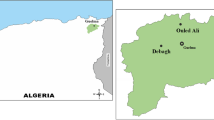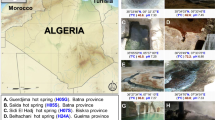Abstract
Studying the culturable portion of environmental bacterial populations is valuable for understanding the ecology, for discovering taxonomically interesting isolates and for exploiting their enzymatic abilities. In this study, diverse water-related samples, iced water (3 °C) from river, the sediment (29 °C) and water (55 °C) of a hot-spring, were investigated by two cultivation strategies, Dry and novel Wet approach. The isolates were clustered by fluorescent internal transcribed spacer PCR and identified by 16S rRNA sequencing. Several bacterial groups were also sub-typed through the application of Random Amplified Microsatellite Polymorphisms method. A broad enzymatic screening of all bacterial isolates was performed in order to assess the proteolytic, cellulolytic, lipolytic, esterolytic, amylolytic properties, as well as catalase and peroxidase activities. The Wet cultivation demonstrated to be suitable for the isolation of potential new species belonging to genera Massilia, Algoriphagus, Rheinheimera and Pandoraea. Valuable microbial resources with extensive enzymatic activities were recognized among the psychrophilic (Pantoea brenneri and Serratia sp.), mesophilic (Pandoraea, Massilia, Pseudomonas, Stenotrophomonas, Bacillus and Aeromonas) and thermophilic bacteria (Aeribacullus pallidus and Geobacillus kaustophilus). The experimental strategy developed in this study includes simple investigation tools able to reveal the genetic and enzymatic peculiarities of isolated microorganisms. It can be applied to different kinds of aquatic samples and extreme environments similar to those described in this study.




Similar content being viewed by others
References
Albertsen M, Hugenholtz P, Skarshewski A, Nielsen KL, Tyson GW, Nielsen PH (2013) Genome sequences of rare, uncultured bacteria obtained by differential coverage binning of multiple metagenomes. Nat Biotechnol 31:533–538
Allen MJ, Edberg SC, Reasoner DJ (2004) Heterotrophic plate count bacteria—what is their significance in drinking water? Int J Food Microbiol 92:265–274
Arnosti C, Bell C, Moorhead DL, Sinsabaugh RL, Steen AD, Stromberger M, Wallenstein M, Weintraub MN (2014) Extracellular enzymes in terrestrial, freshwater, and marine environments: perspectives on system variability and common research needs. Biogeochemistry 117:5–21
Arya M, Joshi GK, Gupta AK, Kumar A, Raturi A (2015) Isolation and characterization of thermophilic bacterial strains from Soldhar (Tapovan) hot spring in Central Himalayan Region, India. Ann Microbiol 65:1457–1464
Bergquist LP, Morgan WH, Saul D (2014) Selected enzymes from extreme thermophiles with applications in biotechnology. Curr Biotechnol 3:45–59
Bollmann A, Lewis K, Epstein SS (2007) Incubation of environmental samples in a diffusion chamber increases the diversity of recovered isolates. Appl Environ Microbiol 73:6386–6390
Bowman JP, Mancuso Nichols C, Gibson JAE (2003) Algoriphagus ratkowskyi gen. nov., sp. nov., Brumimicrobium glaciale gen. nov., sp. nov., Cryomorpha ignava gen. nov., sp. nov. and Crocinitomix catalasitica gen. nov., sp. nov., novel flavobacteria isolated from various polar habitats. Int J Syst Evol Microbiol 53:1343–1355
Brettar I, Christen R, Hofle MG (2002) Rheinheimera baltica gen. nov., sp. nov., a blue-coloured bacterium isolated from the central Baltic sea. Int J Syst Evol Microbiol 52:1851–1857
Bučková M, Puškarová A, Chovanová K, Kraková L, Ferianc P, Pangallo D (2013) A simple strategy for investigating the diversity and hydrocarbon degradation abilities of cultivable bacteria from contaminated soil. World J Microbiol Biotechnol 29:1085–1098
Cavicchioli R, Charlton T, Ertan H, Omar SM, Siddiqui KS, Williams TJ (2011) Biotechnological uses of enzymes from psychrophiles. Microb Biotechnol 4:449–460
Chebeňová V, Berta G, Kuchta T, Brežná B, Pangallo D (2010) Randomly-amplified microsatellite polymorphism for preliminary typing of lactic acid bacteria from bryndza cheese. Folia Microbiol 55:598–602
Chen CY, Kuo JT, Cheng CY, Huang YT, Ho IH, Chung YC (2009) Biological decolorization of dye solution containing malachite green by Pandoraea pulmonicola YC32 using a batch and continuous system. J Hazard Mater 172:1439–1445
Chen R, Guo L, Dang H (2011) Gene cloning, expression and characterization of a cold-adapted lipase from a psychrophilic deep-sea bacterium Psychrobacter sp. C18. World J Microbiol Biotechnol 27:431–441
Claiborne A, Fridovich I (1979) Purification of the o-dianisidine peroxidase from Escherichia coli B. Physicochemical characterization and analysis of its dual catalatic and peroxidatic activities. J Biol Chem 254:4245–4252
Ezeji TC, Wolf A, Bahl H (2005) Isolation, characterization, and identification of Geobacillus thermodenitrificans HRO10, an α-amylase and α-glucosidase producing thermophile. Can J Microbiol 51:685–693
Gugliandolo C, Lentini V, Spanò A, Maugeri TL (2012) New bacilli from shallow hydrothermal vents of Panarea Island (Italy) and their biotechnological potential. J Appl Microbiol 112:1102–1112
Hoehler TM, Jørgensen BB (2013) Microbial life under extreme energy limitation. Nat Rev Microbiol 11:83–94
Huey B, Hall J (1989) Hypervariable DNA fingerprinting in Escherichia coli: minisatellite probe from bacteriophage M13. J Bacteriol 171:2528–2532
Janda JM, Abbott SL (2010) The genus Aeromonas: taxonomy, pathogenicity, and infection. Clin Microbiol Rev 23:35–73
Kämpfer P, Lodders N, Martin K, Falsen E et al (2011) Revision of the genus Massilia La Scola et al. 2000, with an emended description of the genus and inclusion of all species of the genus Naxibacter as new combinations, and proposal of Massilia consociata sp. nov. Int J Syst Evol Microbiol 61:1528–1533
Katara J, Deshmukh R, Singh NK, Kaur S (2012) Molecular typing of native Bacillus thuringiensis isolates from diverse habitats in India using REP-PCR and ERIC-PCR analysis. J Gen Appl Microbiol 58:83–94
Kim M, Morrison M, Yu Z (2011) Evaluation of different partial 16S rRNA gene sequence regions for phylogenetic analysis of microbiomes. J Microbiol Methods 84:81–87
Kolmakova OV, Gladyshev MI, Rozanov AS, Peltek SE, Trusova MY (2014) Spatial biodiversity of bacteria along the largest Arctic river determined by next-generation sequencing. FEMS Microbiol Ecol 89:442–450
La Scola B, Birtles RJ, Mallet MN, Raoult D (1998) Massilia timonae gen. nov., sp. nov., isolated from blood of an immunocompromised patient with cerebellar lesions. J Clin Microbiol 36:2847–2852
Lane DJ (1991) 16S/23S rRNA sequencing. In: Stackenbrandt E, Goodfellow M (eds) Nucleic acid techniques in bacterial systematics. Wiley, New York, pp 115–148
Liz JAZE, Jan-Roblero J, de la Serna JZD, de León AVP, Hernández-Rodríguez C (2009) Degradation of polychlorinated biphenyl (PCB) by a consortium obtained from a contaminated soil composed of Brevibacterium, Pandoraea and Ochrobactrum. World J Microbiol Biotechnol 25:165–170
Maiti B, Raghunath P, Karunasagar I, Karunasagar I (2009) Typing of clinical and environmental strains of Aeromonas spp. using two PCR based methods and whole cell protein analysis. J Microbiol Methods 78:312–318
Margesin R, Miteva V (2011) Diversity and ecology of psychrophilic microorganisms. Res Microbiol 162:346–361
Moquin SA, Garcia JR, Brantley SL, Takacs-Vesbach CD, Shepherd UL (2012) Bacterial diversity of bryophyte-dominant biological soil crusts and associated mites. J Arid Environ 87:110–117
Nagy ML, Pérez A, Garcia-Pichel F (2005) The prokaryotic diversity of biological soil crusts in the Sonoran Desert (Organ Pipe Cactus National Monument, AZ). FEMS Microbiol Ecol 54:244–245
Nichols D, Cahoon N, Trakhtenberg EM, Pham L, Mehta A, Belanger A, Kanigan T, Lewis K, Epstein SS (2010) Use of ichip for high-throughput in situ cultivation of “uncultivable” microbial species. Appl Environ Microbiol 76:2445–2450
Pangallo D, Kraková L, Chovanová K, Bučková M, Puškarová A, Šimonovičová A (2013) Disclosing a crypt: microbial diversity and degradation activity of the microflora isolated from funeral clothes of Cardinal Peter Pázmány. Microbiol Res 168:289–299
Pangallo D, Bučková M, Kraková L, Puškárová A, Šaková N, Grivalský T, Chovanová K, Zemánková M (2015) Biodeterioration of epoxy resin: a microbial survey through culture-independent and culture-dependent approaches. Environ Microbiol 17:462–479
Park J, Kerner A, Burns MA, Lin XN (2011) Microdroplet-enabled highly parallel co-cultivation of microbial communities. PLoS One 6:e17019
Pinar G, Kraková L, Pangallo D, Piombino-Mascali D, Maixner F, Zink A, Sterflinger K (2014) Halophilic bacteria are colonizing the exhibition areas of the Capuchin Catacombs in Palermo, Italy. Extremophiles 18:677–691
Prakash O, Shouche Y, Jangid K, Kostka JE (2013) Microbial cultivation and the role of microbial resource centers in the omics era. Appl Microbiol Biotechnol 97:51–62
Roggenkamp R, Sahm H, Wagner F (1974) Microbial assimilation of methanol induction and function of catalase in Candida boidinii. FEBS Lett 41:283–286
Rompré A, Servais P, Baudart J, de-Roubin MR, Laurent P (2002) Detection and enumeration of coliforms in drinking water: current methods and emerging approaches. J Microbiol Methods 49:31–54
Sambrook J, Fritsch EF, Maniatis T (1989) Molecular cloning, vol 3. Cold spring harbor laboratory press, New York, p A1
Schallmey M, Singh A, Ward OP (2004) Developments in the use of Bacillus species for industrial production. Can J Microbiol 50:1–17
Silby MW, Winstanley C, Godfrey SA, Levy SB, Jackson RW (2011) Pseudomonas genomes: diverse and adaptable. FEMS Microbiol Rev 35:652–680
Song ZQ, Wang FP, Zhi XY, Chen JQ, Zhou EM, Liang F, Xiao X, Tang SK, Jiang HC, Zhang CL, Dong H, Li WJ (2013) Bacterial and archaeal diversities in Yunnan and Tibetan hot springs China. Environ Microbiol 15:1160–1175
Szabó G, Khayer B, Rusznyák A, Tátrai I, Dévai G, Márialigeti K, Borsodi AK (2011) Seasonal and spatial variability of sediment bacterial communities inhabiting the large shallow Lake Balaton. Hydrobiologia 663:217–232
Van Den Burg B (2003) Extremophiles as a source for novel enzymes. Curr Opin Microbiol 6:213–218
Vaz-Moreira I, Nunes OC, Manaia CM (2012) Diversity and antibiotic resistance in Pseudomonas spp. from drinking water. Sci Total Environ 426:366–374
Wu KS, Jones R, Danneberger L, Scolnik PA (1994) Detection of microsatellite polymorphisms without cloning. Nucleic Acids Res 22:3257–3258
Xu F (2005) Applications of oxidoreductases: recent progress. Ind Biotechnol 1:38–50
Zeigler DR (2014) The Geobacillus paradox: why is a thermophilic bacterial genus so prevalent on a mesophilic planet? Microbiology 160:1–11
Author information
Authors and Affiliations
Corresponding author
Electronic supplementary material
Below is the link to the electronic supplementary material.
Rights and permissions
About this article
Cite this article
Grivalský, T., Bučková, M., Puškárová, A. et al. Water-related environments: a multistep procedure to assess the diversity and enzymatic properties of cultivable bacteria. World J Microbiol Biotechnol 32, 42 (2016). https://doi.org/10.1007/s11274-015-1997-9
Received:
Accepted:
Published:
DOI: https://doi.org/10.1007/s11274-015-1997-9




